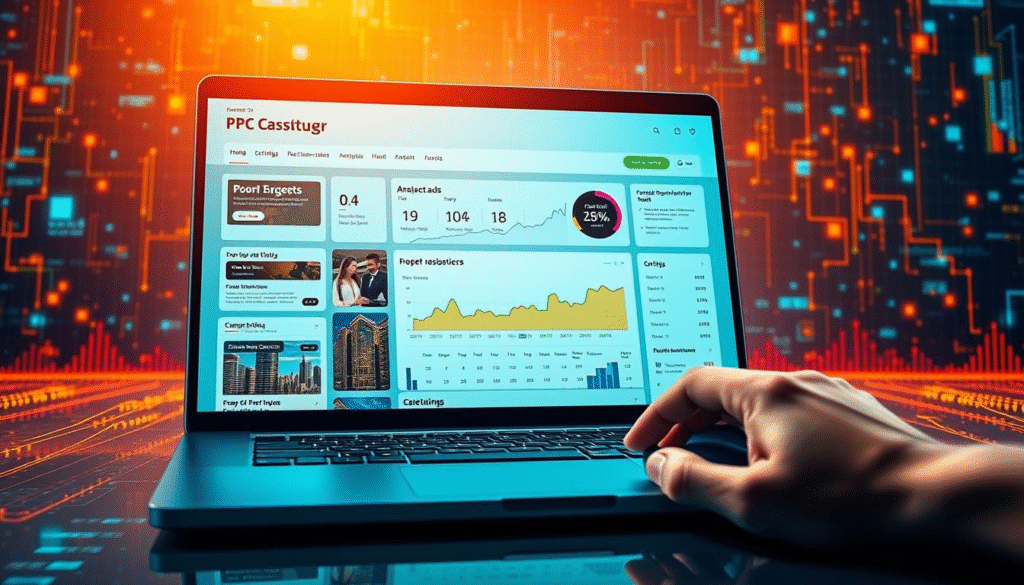In today’s fast-paced business world, companies are always searching for new ways to connect with their audience. Did you know that digital marketing has become a key tool, helping businesses reach consumers in new ways?

Online marketing has changed how businesses work, making it simpler to find their audience. Now, companies can grow their brand, increase website visits, and get more leads.
Key Takeaways
- Understanding the importance of digital marketing in today’s business landscape
- Learning effective online marketing strategies to reach your target audience
- Discovering how to build brand awareness and drive website traffic
- Exploring ways to generate leads and boost conversions
- Developing a complete digital marketing plan for success
The Digital Marketing Landscape in 2023
In 2023, the digital marketing landscape is changing fast. New trends, AI, and better user experiences are leading the way. These changes are making marketing more personal and effective.
Key Industry Trends Shaping the Market
Several trends are shaping the digital marketing world. Personalized marketing and video content are becoming more popular. Brands are using these to connect better with their audience.
Another big trend is data-driven decision-making. Marketers are using advanced analytics to understand their audience. This helps them improve their strategies.
The Impact of AI and Automation
AI and automation are changing marketing for the better. AI helps with predictive analytics, content generation, and customer service chatbots. Automation makes tasks easier, so marketers can focus on big ideas.
AI also makes marketing more personal. It analyzes data to send targeted messages. This boosts engagement and sales.
Mobile-First Approach: Why It Matters
A mobile-first approach is key today. Most people use mobile devices to access the internet. A mobile-first strategy makes sure marketing works well on small screens.
This means designing websites and ads for mobile. It’s about responsive design, fast loading times, and easy navigation. By focusing on mobile, businesses can offer a better user experience. This leads to more engagement and sales.
Building a Comprehensive Digital Marketing Strategy
To succeed online, businesses need a solid digital marketing plan. This plan should match their goals. It includes several key parts that help achieve results.
Setting SMART Marketing Objectives
The first step is to set SMART (Specific, Measurable, Achievable, Relevant, Time-bound) marketing goals. These goals should match your business aims. They guide your marketing actions.
- Specific: Clearly define what you want to achieve.
- Measurable: Quantify your objectives so progress can be tracked.
- Achievable: Ensure your objectives are realistic based on your resources.
- Relevant: Align your objectives with your business goals.
- Time-bound: Set deadlines for achieving your objectives.
Identifying Your Target Audience
Knowing your target audience is key for good marketing. You need to understand their demographics, preferences, behaviors, and pain points. This helps create detailed buyer personas.
With this knowledge, you can tailor your messages and marketing channels. This makes your campaigns more likely to succeed.
Competitive Analysis Techniques
Doing a competitive analysis shows where you stand in the market. It helps find ways to stand out. You look at your competitors’ strengths, weaknesses, and marketing plans.
- Identify your main competitors.
- Analyze their marketing channels and campaigns.
- Assess their strengths and weaknesses.
- Determine how you can differentiate your brand.
Creating a Marketing Budget
Having a budget for digital marketing is vital. It lets you execute your plan well. Your budget should match your goals, marketing channels, and needed resources.
Think about spending on content, ads, SEO, and social media. Keep checking and adjusting your budget to stay on track with your goals.
Search Engine Optimization (SEO) Fundamentals
Most online experiences start with a search engine. Knowing SEO is key for businesses to keep up. “SEO is the foundation upon which all other digital marketing efforts are built,” a top expert says. Good SEO can make your website more visible, bringing in more leads and sales.
On-Page SEO Best Practices
On-page SEO makes your web pages better for search engines. Important steps include:
- Do thorough keyword research to find the right terms.
- Make sure meta tags like title tags and meta descriptions are clear.
- Use header tags (H1, H2, H3, etc.) to organize content and highlight keywords.
- Create engaging content that’s valuable and uses target keywords naturally.
- Keep URL structures clean and descriptive, with target keywords when possible.
Off-Page SEO Strategies
Off-page SEO builds your website’s authority and reputation. Good strategies are:
- Link building: Get high-quality backlinks from trusted sites to boost your site’s credibility.
- Social media engagement: Social media can increase traffic and brand visibility, even if it’s not a direct ranking factor.
- Reviews and ratings: Get customers to leave reviews on platforms like Google My Business to improve local SEO.
Technical SEO Essentials
Technical SEO makes your website better for search engines. Key areas include:
Site Speed Optimization
Fast site speed is good for users and search engines. Improve it by optimizing images, using browser caching, and reducing HTTP requests.
Mobile Responsiveness
Most searches are on mobile devices. A mobile-responsive design is essential for a good user experience on all devices.
Structured Data Implementation
Structured data, or schema markup, helps search engines understand your content. It can also make your search results more attractive with rich snippets. Use it for reviews, events, and FAQs.
By focusing on these SEO basics, businesses can get more online visibility, attract more targeted traffic, and increase sales. As “The more visible you are online, the more likely you are to be found by customers.”
Content Marketing That Drives Results
The power of content marketing is in engaging your audience with valuable content. In today’s digital world, businesses seek effective ways to connect with their audience.
A well-thought-out content strategy is key to meeting marketing goals. It means knowing your audience, creating content they’ll love, and sharing it through the best channels.
Content Strategy Development
Creating a content strategy involves several steps:
- Know your target audience and what they need
- Set clear goals for your content
- Plan your content with a calendar
- Pick the best channels to share your content
Creating Engaging Blog Content
Blogging is a top way to connect with your audience. To make your blog content engaging, focus on:
- Understanding what your audience cares about
- Writing catchy headlines and introductions
- Adding visuals like images and videos
- Using the right keywords to optimize your content
Video Marketing Essentials
Video marketing is popular for making complex info easy to understand. Key video marketing tips include:
- Make high-quality, relevant, and consistent videos
- Use different video types like explainer videos and live streams
- Optimize your videos for YouTube, social media, and your website
Content Distribution Channels
Getting your content to the right people is key. Common channels include:
| Channel | Description | Benefits |
| Social Media | Platforms like Facebook, Twitter, and LinkedIn | High engagement, targeted ads |
| Email Newsletters | Regular newsletters to subscribers | Direct communication, high conversion rates |
| Influencer Marketing | Working with influencers in your niche | Increased reach, credibility |
By using these content marketing strategies, businesses can achieve real results and meet their marketing goals.
Social Media Marketing Tactics
Social media marketing tactics are key for companies wanting to boost their brand and connect with people. With social media always changing, businesses must keep up to reach their audience.
Platform Selection Strategy
Picking the right social media platforms is vital for marketing success. It’s important to find out where your target audience is most active and focus there.
- Do research to see where your audience likes to be
- Look at what your competitors are doing online
- Think about what kind of content works best on each platform
Content Calendar Creation
A good content calendar is the core of a strong social media plan. It helps in organizing content ahead of time and keeps things consistent.
To make a great content calendar, consider these steps:
- Plan content around big events and holidays
- Include different types of content, like promotions and fun posts
- Use tools to make publishing easier
Community Building Techniques
Building a strong community around your brand is key for success on social media. Interacting with your audience and making them feel part of something can turn them into loyal fans.
Good ways to build a community include:
- Always respond to comments and messages
- Encourage your followers to share their own content
- Host live events or Q&A sessions
Measuring Social Media ROI
It’s important to measure how well your social media efforts are doing. Tracking important metrics and looking at the data can help you improve your strategy.
To measure social media ROI, focus on these metrics:
| Metric | Description | Importance |
| Engagement Rate | Measures how people interact with your content | High |
| Conversion Rate | Tracks what actions users take | High |
| Follower Growth Rate | Monitors how many new followers you get | Medium |
As social media expert Brian Solis says, “The art of marketing is long gone. The new art is being as relevant as possible.”
“The art of marketing is long gone. The new art is being as relevant as possible.”
Brian Solis
Pay-Per-Click (PPC) Advertising
PPC advertising is a top choice in digital marketing. It lets advertisers pay for each ad click, making it a direct way to get more website visitors.
Campaign Structure in Google Ads
Setting up a Google Ads campaign right is key. You need to organize campaigns, ad groups, and ad copy that match your target keywords.
Key Components of a Google Ads Campaign:
- Campaign settings that define budget, location, and language
- Ad groups that organize ads and keywords
- Ad copy that resonates with the target audience

Keyword Research and Selection
Keyword research is the base of a good PPC campaign. It’s about finding the right keywords that match your business goals.
| Keyword | Search Volume | Competition |
| Digital Marketing | 1000 | High |
| PPC Advertising | 500 | Medium |
| Google Ads | 800 | High |
Ad Copy Optimization
Improving ad copy is vital for better click-through and conversion rates. You need to write catchy headlines, descriptions, and URLs that grab the audience’s attention.
Best Practices for Ad Copy Optimization:
- Use relevant keywords in headlines and descriptions
- Incorporate a clear call-to-action (CTA)
- Test different ad variations
Landing Page Conversion Tactics
Optimizing landing pages is essential for turning clicks into sales. Make sure your landing pages are relevant, easy to use, and focused on conversions.
Key Elements of a High-Converting Landing Page:
- Clear and concise messaging
- Prominent call-to-action (CTA)
- Relevant and engaging content
Email Marketing Strategies
Email marketing is key for businesses to grow their leads and sales. It lets you send personalized messages to the right people. This makes it a must-have for marketers today.
Building and Segmenting Your Email List
Starting a strong email list is the first step. You can do this by adding sign-up forms on your site, giving incentives, and following data rules.
Segmenting your list is also important. It helps you send the right message to different groups. You can segment based on who they are, what they buy, and how they interact with your emails.
- Demographic segmentation: Age, gender, location
- Behavioral segmentation: Purchase history, browsing behavior
- Engagement segmentation: Open rates, click-through rates
Crafting High-Converting Email Campaigns
Creating emails that work needs a few key things. First, your subject line should grab attention. Then, your content should be interesting, personal, and match what the person wants.
Use personalization techniques like using names and tailoring content. Also, make sure your call-to-action (CTA) is clear and direct. This tells the reader what to do next.
| Email Campaign Element | Best Practice |
| Subject Line | Keep it concise and compelling |
| Email Content | Personalize and make it relevant |
| Call-to-Action (CTA) | Clear, prominent, and actionable |
Automation Workflows That Convert
Email automation sends emails at the right time without you doing it. Welcome emails, abandoned cart reminders, and birthday greetings are great examples. They help keep customers engaged.
To set up good automation, find triggers (like when someone subscribes or buys) and plan out your email sequence. Use marketing tools to make it easier.
A/B Testing for Optimization
A/B testing compares two versions of an email to see which one works better. You can test subject lines, content, CTAs, and when you send them.
By looking at A/B test results, you learn what your audience likes. This helps you make your emails better over time.
Analytics and Performance Measurement
Analytics is key to a successful digital marketing strategy. It shows how well your campaigns are doing. In today’s world, knowing how your digital marketing performs is vital for smart decisions.
Setting Up Google Analytics 4
Setting up Google Analytics 4 (GA4) is a big first step. GA4 gives a deeper look at how users behave on different devices. To start, go to your Google Analytics account, make a new property, and follow the setup steps.
Key steps in setting up GA4 include:
- Defining your data retention period
- Configuring your data stream settings
- Integrating GA4 with other Google tools like Google Ads
Key Performance Indicators (KPIs)
Finding the right KPIs is key to measuring your campaign success. KPIs should match your marketing goals. This could be more website visitors, higher conversion rates, or better customer interaction.
Common KPIs include:
- Website traffic metrics (sessions, users, bounce rate)
- Conversion metrics (conversion rate, transactions)
- Engagement metrics (session duration, pages per session)
| KPI | Description | Importance |
| Conversion Rate | Percentage of users who complete a desired action | High |
| Bounce Rate | Percentage of users who leave the site without taking further action | Medium |
| Session Duration | Average time users spend on your site | Medium |
Creating Custom Dashboards
Custom dashboards in Google Analytics 4 let you see your KPIs in a way that matters to your business. They help you quickly see how your campaigns are doing and where you can get better.
“The key is not to prioritize what’s on your schedule, but to schedule your priorities.” – Stephen Covey
To make a custom dashboard, go to the “Analysis” section in GA4, choose “Custom Analysis,” and start adding the KPIs that are most important to your business.
Data-Driven Decision Making
Decisions based on data are essential for improving your digital marketing strategy. By looking at your KPIs and using tools like GA4, you can see what’s working and what’s not. This lets you change your strategy to do better.

For example, if an ad campaign isn’t doing well, you can move your budget to better ones. Also, if certain content is more popular, you can make more of it.
Emerging Digital Marketing Channels
New digital marketing channels are changing how businesses talk to their customers. Technology keeps getting better, and people’s habits are changing too. This means new ways to connect with people are showing up.
Influencer Marketing Strategies
Influencer marketing is key for many digital marketing plans. By working with influencers, brands can reach people who really listen to them.
To make influencer marketing work, think about these tips:
- Find influencers who match your brand and audience.
- Set clear goals and rules for the influencer.
- Ask for real content that speaks to the influencer’s fans.
Podcast Advertising Opportunities
Podcast ads are growing, giving brands a special way to connect with listeners. As more people tune into podcasts, brands are finding creative ways to share their messages.
Good podcast ads need:
- Pick podcasts that fit your audience’s interests.
- Create ads that really speak to listeners.
- Track how well ads work with special codes or URLs.
Voice Search Optimization
Voice assistants are getting more popular, making voice search optimization key. Voice searches are different from typed searches, so you need a special SEO plan.
To get better at voice search:
- Use natural language and long-tail keywords.
- Make sure your site works well on mobile and loads fast.
- Use structured data to help search engines get your content.
Augmented Reality Marketing
Augmented Reality (AR) is changing marketing by adding immersive experiences. From virtual try-ons to interactive ads, AR is making marketing more fun and engaging.
| Emerging Channel | Key Benefits | Implementation Strategies |
| Influencer Marketing | Targeted reach, increased credibility | Partner with aligned influencers, create authentic content |
| Podcast Advertising | Engaged audience, niche targeting | Select relevant podcasts, measure with promo codes |
| Voice Search Optimization | Improved visibility, natural language integration | Focus on long-tail keywords, ensure mobile-friendliness |
| Augmented Reality Marketing | Immersive experiences, enhanced engagement | Develop interactive AR content, integrate with existing campaigns |
As these new digital marketing channels grow, businesses that keep up and get creative will connect better with their audience. This will help them succeed in the digital world.
Integrating Your Digital Marketing Efforts
In today’s digital world, combining marketing efforts is essential for success. A strong online presence comes from a well-thought-out plan. This plan should use different digital marketing channels and strategies.
Cross-Channel Campaign Coordination is key to keeping your message the same everywhere. You need to match your message, look, and goals on social media, email, SEO, and ads.
Cross-Channel Campaign Coordination
To do cross-channel coordination well, businesses should:
- Have a single marketing plan for all digital channels.
- Use data to see how customers interact on different platforms.
- Keep branding and messages the same in all marketing materials.

Marketing Automation Tools
Marketing automation tools are important for making digital marketing better. They help with tasks that repeat, make customer interactions personal, and check how well campaigns do.
Marketing automation offers many benefits, like:
- Doing tasks automatically saves time.
- Personalized content makes customers more engaged.
- It helps in making better decisions with data.
Customer Journey Mapping
Knowing the customer journey is key for good marketing. It’s about seeing all the ways customers interact with your brand, from first seeing your brand to buying from you.
By mapping the customer journey, businesses can:
- Find out where they struggle and improve.
- Make marketing that speaks to their needs.
- Make their marketing better to meet customer needs.
Omnichannel Marketing Approach
An omnichannel marketing strategy means giving customers a smooth experience everywhere. It needs understanding what customers like and how to use many marketing channels together.
With an omnichannel approach, businesses can:
- Keep customers engaged and loyal.
- Make their brand more consistent and well-known.
- Grow sales and revenue.
In summary, combining digital marketing is vital for a strong online presence and good ROI. By using cross-channel coordination, marketing automation, mapping the customer journey, and an omnichannel strategy, businesses can build a strong digital marketing plan.
Conclusion
In wrapping up our exploration of digital marketing strategies, several key takeaways emerge. We’ve looked at the digital marketing landscape, from the importance of a mobile-first approach to using AI and automation.
Key strategies include building a detailed digital marketing plan, optimizing for SEO, and using content marketing, social media, and PPC advertising well. As digital marketing continues to evolve, staying adaptable and informed is key.
“The best marketing doesn’t feel like marketing.” – Tom Fishburne
By using these strategies and focusing on the customer, businesses can grow a lot. It’s clear that a good digital marketing strategy is now essential for success in today’s market.
Sources
For more insights on digital marketing strategies and trends, we looked at these sources:
- Search Engine Journal: A top publication on SEO and digital marketing news.
- Moz: Known for SEO best practices and industry analysis.
- Social Media Today: Offers the latest in social media marketing trends and strategies.
- WordStream: A great resource for PPC advertising and digital marketing optimization.
These sources are full of information on the latest in digital marketing. They help businesses stay competitive in the digital world.
FAQ
What is the importance of having a mobile-first approach in digital marketing?
A mobile-first approach is key in digital marketing. It makes sure your site and marketing work well on mobiles. This gives users a better experience and helps your site rank higher in searches.
How do I identify my target audience for digital marketing?
To find your target audience, start with market research. Look at your customer data and create buyer personas. These should cover demographics, needs, and preferences.
What is the role of AI and automation in digital marketing?
AI and automation are big in digital marketing. They help personalize marketing, boost efficiency, and guide decisions with data.
How can I measure the ROI of my social media marketing efforts?
To see the ROI of your social media, track metrics like engagement and sales. Use tools like Google Analytics to understand your data.
What is the difference between on-page and off-page SEO?
On-page SEO focuses on your site’s content and structure. Off-page SEO looks at external factors like backlinks and social signals that affect rankings.
How can I optimize my email marketing campaigns for better conversions?
To boost your email marketing, segment your list and write compelling content. Use A/B testing to get better open and click rates.
What is the importance of analytics and performance measurement in digital marketing?
Analytics and performance tracking are vital in digital marketing. They help you see how well your marketing is doing, find areas to improve, and make informed decisions.
How can I integrate my digital marketing efforts across different channels?
To tie your digital marketing together, use automation tools and plan a cross-channel strategy. Map your customer’s journey for a smooth brand experience.
What are some emerging digital marketing channels that I should consider?
Look into influencer marketing, podcast ads, voice search, and augmented reality marketing. These are new areas to explore in digital marketing.
How can I improve my website’s loading speed for better SEO?
To speed up your site, optimize images and minify code. Use caching and a CDN to cut down page load times.
